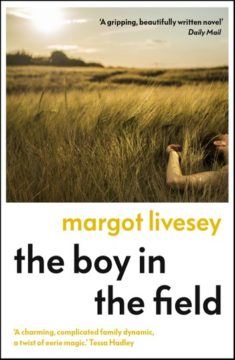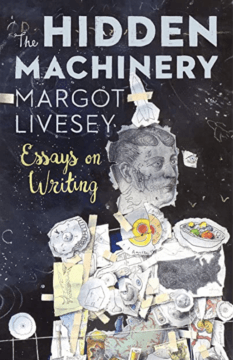by Philip Graham
 Margot Livesey’s The Boy in the Field is a mystery novel in the broadest sense of that literary term. Yes, the novel begins with the discovery of a crime, and the perpetrator remains at large for most of the narrative. Yet the “what happened next” of a standard mystery novel concentrates on the three siblings who came upon the victim lying in a field, the reverberations of that event on their young lives, and of the family they are a part of. “Mystery” can reside within all of us, to locate or evade, and that is the deeper reveal that Livesey hunts for in this wise and haunting book.
Margot Livesey’s The Boy in the Field is a mystery novel in the broadest sense of that literary term. Yes, the novel begins with the discovery of a crime, and the perpetrator remains at large for most of the narrative. Yet the “what happened next” of a standard mystery novel concentrates on the three siblings who came upon the victim lying in a field, the reverberations of that event on their young lives, and of the family they are a part of. “Mystery” can reside within all of us, to locate or evade, and that is the deeper reveal that Livesey hunts for in this wise and haunting book.
Philip Graham: In your novel, The Boy in the Field, Duncan makes an observation about his family: “During his brief period as a Boy Scout, he had learned that the compass has thirty-two points. Now he could say with confidence that each person in his family was heading toward a different one.” This insight of Duncan’s seems to be the basso ostinado of your novel’s structure: how do members of a family find their individual paths while still remaining a unit called a family?
Margot Livesey: What a great phrase: phrase basso ostinato. Years ago, I read a quotation by Katherine Mansfield, (from her diary, I think) musing about her great story “Prelude.” Even in the happiest of families, she claimed, every member is striving desperately to get free. In The Boy in the Field I hoped to show what is, in many respects, a happy family but one in which, as Duncan remarks, everyone is heading in a different direction. How far can they go, on their separate quests, without threatening the family? The father’s affair threatens it in one way; Duncan’s search for his birth mother in another. Matthew’s and Zoe’s quests are less immediately threatening but also carry them away from the family. Perhaps that’s why they all need Lily, Duncan’s almost perfect dog.
PG: I like that Mansfield quote, an improvement over Tolstoy’s “Happy families are all alike; every unhappy family is unhappy in its own way,” a statement that seems to me to be utterly inaccurate in every way. I’ve always thought even the happiest family can have sadness laced through it, while the worst families are capable of crumbs of comfort or truce. Anyway, while The Boy in the Field overtly offers a mystery about an unsolved crime, the novel’s true mystery is centered around how the glue of the Lang family might hold, with the perspectives of the three Lang children alternating throughout the narrative.
 ML: I love that you take on Tolstoy’s great truism, so frequently quoted, so little examined. Ever since Sherlock Holmes solved a crime by figuring out why the dog didn’t bark in the night time, it’s been part of the appeal of mysteries and whodunnits that they offer a solution; the worst happens but order is restored. This seems to me very unlike life. I wanted to have a crime that was explored more realistically, even haphazardly, while at the same time, as you say, really focusing on the Lang family.
ML: I love that you take on Tolstoy’s great truism, so frequently quoted, so little examined. Ever since Sherlock Holmes solved a crime by figuring out why the dog didn’t bark in the night time, it’s been part of the appeal of mysteries and whodunnits that they offer a solution; the worst happens but order is restored. This seems to me very unlike life. I wanted to have a crime that was explored more realistically, even haphazardly, while at the same time, as you say, really focusing on the Lang family.
PG: Yes, the mystery of family! The crime you mention is against the “boy in the field,” Karel Lustig, who has been physically assaulted. The three Lang children discover him, bleeding and unconscious, as they walk home from school. While they wait for an ambulance to arrive, Karel murmurs a single word. Duncan, the youngest hears “cowslip,” Zoe hears “cowrie,” while Matthew hears “coward.” We never discover which word is correct (or if Karel spoke an entirely different word), but that’s not the point. The differences between this one-word possible clue is really our first window into the three individual journeys that Duncan, Zoe, and Matthew are about to undertake.
ML: Exactly. The unreliability of memory is well documented nowadays but I’m also interested in the disconcerting fact that we all perceive the world differently. As we navigate through a day our senses and our thoughts are our main guides but what if those guides can’t be trusted? I wanted to suggest early in the novel that Matthew, Zoe and Duncan, although living under one roof, experience the world very differently. I also wanted to suggest that this would not be a traditional detective novel in which everything can, finally, be known; as in life some things will remain hidden.
PG: Hmmm, sounds like the budding artist Duncan, who wants to “make pictures where a lot is left out but people fill in the details.”
ML: Perhaps you’ll recognize that Duncan is paraphrasing Elmore Leonard? When I was driving back and forth between Cambridge and Bowdoin College, I listened to several of Leonard’s novels and came to appreciate his claim that he leaves out what other writers include. That seems to me a wonderful description of the late work of the Italian painter Giorgio Morandi – his groups of vases, like a family, always in relation to each other, getting fainter and fainter.
 PG: Ah, Morandi. Another great pleasure of reading your novel is that it introduced me to that artist’s work. His paintings are a gentle lens for The Boy in the Field, pointing us to the true heart of the book, the expanding mysteries of family. Though your novel begins with a crime, one that must be solved, it seems to me you’re employing the mystery genre in a way that’s similar to your view of Jane Austin’s employing the genre of romance in the revelation of her characters in Persuasion. Austin (as you observe in your excellent craft book, The Hidden Machinery) “practices a kind of synecdoche; the part, romance, stands in for the whole, their social and spiritual beings.”
PG: Ah, Morandi. Another great pleasure of reading your novel is that it introduced me to that artist’s work. His paintings are a gentle lens for The Boy in the Field, pointing us to the true heart of the book, the expanding mysteries of family. Though your novel begins with a crime, one that must be solved, it seems to me you’re employing the mystery genre in a way that’s similar to your view of Jane Austin’s employing the genre of romance in the revelation of her characters in Persuasion. Austin (as you observe in your excellent craft book, The Hidden Machinery) “practices a kind of synecdoche; the part, romance, stands in for the whole, their social and spiritual beings.”
ML: Genre is something I seldom used to think about. It didn’t seem relevant to the kind of novels I aspired to write. But I now understand that genre has to do with expectations and that’s a crucial aspect of writing. Even when our work doesn’t fit into an exact form, we’re still signaling to the reader whether they can look forward to a comedy or a tragedy or some mixture of the two. In Banishing Verona, I tried to follow Austin’s rules for romance – the couple meets early and is separated for many pages. In The Boy in the Field, I was partly inspired by a real crime – the murder, several decades ago, of a young woman in a tiny Scottish village – and partly by an interview with a mystery writer, (I think Louise Walsh), and her claim that the “detective” is the man or woman of virtue who goes down into the valley of shadow.
PG: I love that definition. And you’ve applied it well: spurred by the shock of their discovery of Karel Lustig’s near-dead body, the three Lang children undertake their separate journeys, as you’ve mentioned, to a “valley of shadow.” The children are growing, as children are wont to do, but where is the countervailing gravitational force that holds the family together? Lily, a dog recently introduced into the Lang household, seems to serve as a calming, emotional glue. And yet, is Lily responsible or do the various Langs instead see in her what they wish or need to see?
ML: I think of each of the children as having a guide on their journey. Hugh Price, the detective, is Matthew’s guide as he tries to find the boy’s assailant. Lily is Duncan’s guide as he tries to find the woman he calls his first mother. Zoe is guided by something more inchoate: her growing sense of herself as a person with romantic impulses. And yes, Lily also has a larger role. Many years ago, Francine Prose and I agreed we would each write a story with a talking animal. She almost immediately wrote the wonderful “The Talking Dog.” I, after more than two decades, found my way to Lily. I grew up believing that our family dog was just about to talk and in my mind Lily really does have extraordinary gifts of empathy and clarity.
PG: Empathy and clarity is just what this family needs, especially when Zoe discovers, by accident, their father’s infidelity. When Duncan later discovers, from an overheard conversation, that the father’s lover is pregnant, the danger to the family’s unfractured existence becomes even more urgent. However, the three children decide to remain silent. They keep this secret from their mother and wait, in trepidation, to see what might eventually be decided by their parents. It’s as if they have taken in some of Lily’s patience and empathy.
ML: Nowadays repression, leaving things unsaid, is often viewed as a bad thing. But I think there’s something powerful, and touching, about everyone in a family knowing something, and no one saying a word. Words do shape experience, they pin it down; allowing something to remain unsaid allows it to remain uncategorized. The Langs, including Lily, are all aware that if anyone mentions Hal’s affair, it will change everything.
PG: “The value of the unsaid” seems to be one of the operative energies in the novel’s penultimate chapter, “The Salon of Second Chances.” This party is held at the end of the year at the village town hall, and attendees are encouraged to “dress up as the person, real or imagined, they’d most like to be.” Usually, costumes are meant to disguise their wearers, but the premise of the Salon is to reveal, though often in an unspoken way, the person behind the polar bear, Inspector Morse, Spinoza, a siren, a terrier, an Irish giant. “[T]here was something about the Salon, full of people in disguise . . . that licensed a certain freedom.” A freedom to speak, even if only through the example of their costumes.
ML: I’ve always loved a good party scene, and what it can do for a story, in terms of bringing characters together and creating an atmosphere in which they might do, or say, something extraordinary. For The Boy in the Field, I wanted a party without a host, a public party, where strangers could show up, and I wanted Karel to be there but not necessarily to be the main focus. It also allowed me to include the parents, Betsy and Hal, in a way that seemed crucial.
PG: Yes, the protection of those costumes seems to loosen everybody up! It’s the perfect moment when all the subplots of the novel—those braiding alternating chapters seen from the perspective of either Matthew, Zoe, or Duncan—come together at the party. Now, in this “Salon of Second Chances” chapter, all three children’s perspectives take their turn, such an artful orchestration. It reminds me of what you write about subplots in The Hidden Machinery: “a successful subplot is one that is interesting and compelling in its own right, resonates with the main plot appropriately, and intersects with it at just the right moment.” Here, the “subplots” reveal themselves to be the fugal heart of the novel.
ML: There are novels that are about only one thing but usually a subplot, or two, like minor characters, is crucial to the story, in terms of both plot and theme. Think of the rude mechanicals in A Midsummer Night’s Dream and how their play, along with the feud between Titania and Oberon, deepens the story of the four lovers and allows time to pass.
At high school, I read a Shakespeare play every term and one of the things I learned was how disguise can be liberating. Often his characters reveal their truest feelings only when pretending to be someone else. His many cases of mistaken identity can seem implausible but we have our own contemporary versions – someone is “disguised” as a good person, or as a bad person.
PG: “The Salon of Second Chances” might easily serve as the final chapter, but instead, in the last chapter, “The Degree Show,” you leap ahead eight years to a further family gathering. Duncan has been studying art in London, and the Langs have convened to appreciate his graduation show. Duncan’s art now embraces abstraction, and he is nervous about his family’s reception of an art form where, as his brother Matthew once observed, “nothing was anything else.” But Duncan’s six untitled abstract paintings are about something, and it’s Matthew who immediately realizes, “You painted the boy in the field.” And at this moment the novel’s title blossoms, from a reference to Karel Lustig’s bleeding body in the grass, to a celebration of art as memorial, witness, and transcendence.
ML: Thank you for understanding so well what I was trying to accomplish. Karel is there in the paintings and the three people, who did save him years ago in the field, bear witness to his presence and to that painful adult discovery of how hard it is to save another person. My husband, Eric Garnick, paints large abstract paintings which are almost like novels – he works on them, sometimes for several years, in many, many layers. What is buried in the painting subtly informs what the viewer finally sees: a sense of depth, of inner space.
PG: Finally, there’s one last lovely touch I can’t help mentioning. The novel’s opening sentence is “Here is what happened one Monday in the month of September, in the last year of the last century.” The first line of the last chapter is an artful echo: “Here is what happened eight and a half years later, on a Thursday shortly before the summer solstice,” which implies that this chapter could serve as the first chapter of the unwritten rest of the story of the Lang family. If they wish, readers can imagine what follows—in a similar fashion, perhaps, as viewers of Duncan’s abstract paintings can imagine the story behind his images.
ML: I did want to create characters whose lives extend beyond the page. Even Karel, who has stopped his life, will continue to affect the lives of those who knew him. While I love the closure of the Victorian novel, our sense of how a life can change has evolved. As Grace Paley argues in her story “A Conversation with my Father” – “Everyone, real or invented, deserves the open destiny of life.” At the same time, we do want a novel to offer what life so seldom does: an end to the story. As I write this, I am about to pay a visit to Oxford and I know I’ll be looking at the city through the eyes of my characters one more time: imagining Matthew heading to the police station, Zoe searching for Rufus in streets and cafes, Duncan making his way to the Ashmolean Museum.
